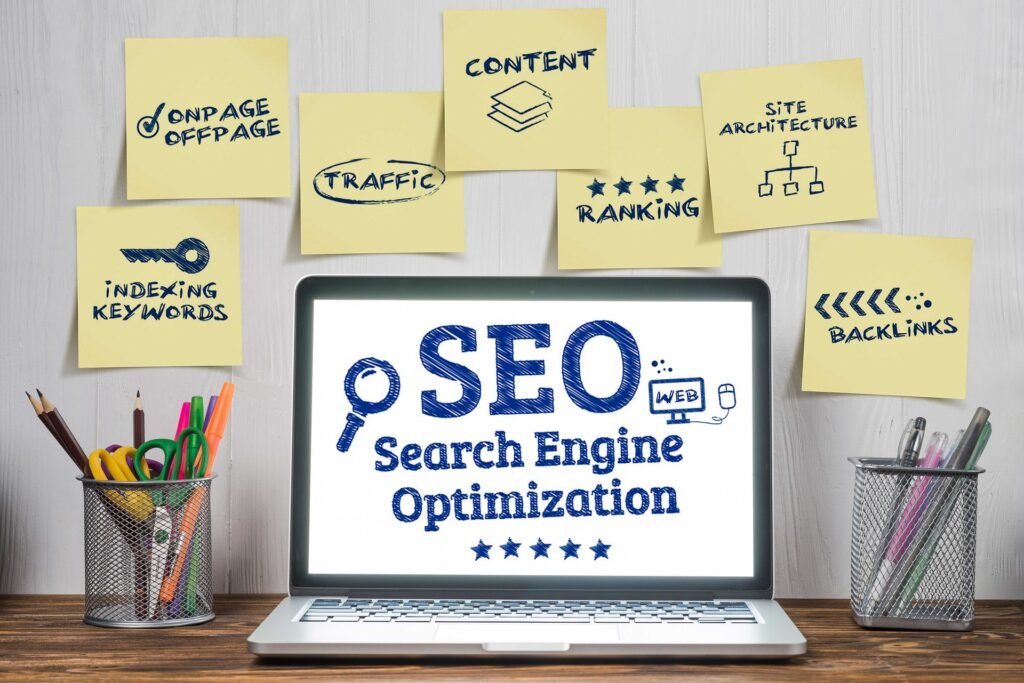Introduction to SEO
In today’s digital landscape, where information is just a few clicks away, Search Engine Optimization (SEO) has become an essential tool for businesses and individuals seeking to enhance their online visibility. SEO involves a series of strategies and techniques designed to improve a website’s ranking on search engine results pages (SERPs) organically, meaning without paid advertising. By understanding and implementing effective SEO practices, websites can gain increased exposure and reach their target audience more effectively.
Importance of SEO
A. Organic Search Traffic
- Majority of Website Traffic Originates from Search Engines: A significant portion of web traffic comes from search engines like Google, Bing, and Yahoo. When users search for information, products, or services, they tend to trust the organic search results more than paid advertisements.
- Credibility and Trust from Organic Listings: Websites that rank higher organically are often perceived as more credible and trustworthy. Users are more likely to click on these results, leading to higher click-through rates and potentially more conversions.
B. Return on Investment (ROI)
- Cost-Effective Marketing Strategy: Unlike paid advertising, where costs can quickly add up, SEO offers a cost-effective approach. While it requires an initial investment, the long-term benefits often outweigh the costs, as the results can be sustained over time.
- Long-Term Benefits: The efforts put into SEO can yield lasting results. Well-optimized content can continue to attract organic traffic and generate leads for months or even years after it’s been published.
C. User Experience (UX)
- SEO and Website Usability: Search engines consider user experience when ranking websites. A well-optimized site tends to provide a better user experience, including fast loading times, easy navigation, and relevant content.
- Mobile-Friendly Optimization: With the majority of searches now happening on mobile devices, having a mobile-friendly website is crucial for both SEO and user satisfaction. Google also factors mobile-friendliness into its ranking algorithm.
D. Competition and Market Share
- Gaining an Edge Over Competitors: In competitive industries, ranking higher in search results can give a business a competitive advantage. Users are more likely to click on one of the top results, potentially leaving competitors behind.
- Establishing Online Presence: SEO is an avenue for small businesses and startups to establish a strong online presence without the need for significant advertising budgets. It levels the playing field by allowing well-optimized websites to compete against larger brands.

How SEO Impacts Website Visibility on Search Engines
A. Search Engine Ranking Factors
1. On-Page Optimization:
-
- Keywords and Content Quality: Targeting relevant keywords and providing valuable content helps search engines understand what a page is about and how it should be ranked.
- Meta Tags and Descriptions: Well-crafted meta titles and descriptions improve click-through rates by giving users a preview of what to expect on the page.
- URL Structure: Descriptive and user-friendly URLs aid both search engines and users in understanding page content.
2. Off-Page Optimization:
-
- Backlinks and Link Building: High-quality backlinks from reputable sources signal authority and relevance to search engines.
- Social Signals: Engaging content that gets shared on social media can indirectly impact search engine rankings.
- Online Reputation Management: Managing online reviews and reputation contributes to a positive online presence, which can influence search rankings.
B. Crawling and Indexing
- Search Engine Bots and Crawlers: Search engines use bots and crawlers to navigate and index web pages. Optimizing for these bots ensures efficient indexing and better visibility.
- XML Sitemaps and Robots.txt: Creating and submitting XML sitemaps helps search engines understand the structure of your website. The robots.txt file guides bots on which pages to crawl and which to avoid.
C. Technical SEO
- Website Speed and Performance: Fast-loading websites provide a better user experience and are favored by search engines.
- Mobile Responsiveness: Mobile-friendly websites are prioritized in mobile search results, reflecting the increasing number of mobile searches.
- Site Architecture and Navigation: A clear and organized site structure makes it easier for search engines to crawl and understand your content, leading to better rankings.

Strategies for Effective SEO
A. Keyword Research and Targeting
- Identifying Relevant Keywords: Thorough keyword research helps you understand what terms your target audience is searching for and allows you to create content that aligns with their interests.
- Long-Tail Keywords and User Intent: Long-tail keywords are more specific phrases that capture user intent. Focusing on these can lead to higher conversion rates as they often indicate users who are closer to making a purchasing decision.
B. Content Creation and Optimization
- High-Quality and Relevant Content: Creating valuable, informative, and engaging content is at the heart of successful SEO. Content that answers users’ questions and provides solutions tends to rank higher.
- Structured Data Markup: Implementing structured data (schema markup) helps search engines understand the context of your content, leading to enhanced visibility in rich snippets and other special search features.
C. Link Building and Authority
- Building Natural and Quality Backlinks: Earning backlinks from authoritative and relevant websites demonstrates credibility to search engines. Focus on creating shareable content and networking within your industry.
- Guest Posting and Influencer Outreach: Collaborating with influencers or authoritative sites through guest posts can not only bring exposure but also build valuable backlinks.
D. User Experience and Engagement
- User-Friendly Design and Navigation: A clean and intuitive website design enhances user experience, reducing bounce rates and encouraging visitors to explore more pages.
- Dwell Time and Bounce Rate: Search engines consider how long users stay on a page (dwell time) and whether they leave immediately (high bounce rate). Engaging content and easy navigation can improve these metrics.
E. Monitoring and Analysis
- Google Analytics and Search Console: These tools provide insights into website traffic, user behavior, and search performance. Regular monitoring helps identify areas for improvement.
- Tracking Keyword Rankings and Traffic: Monitoring your keyword rankings and organic traffic enables you to adjust strategies based on what’s working and what needs improvement.
Future Trends in SEO
A. Voice Search Optimization
As voice-activated devices become more common, optimizing content for voice search queries becomes crucial. Voice search tends to be more conversational and question-based, requiring a shift in keyword targeting and content structure.
B. Featured Snippets and Position Zero
Featured snippets are concise answers displayed at the top of search results. Optimizing content to capture the “position zero” spot can drive significant traffic and establish authority.
C. Artificial Intelligence and Machine Learning in SEO
Search engines are increasingly using AI and machine learning to understand user intent and deliver more accurate results. Understanding and adapting to these technologies will be vital for maintaining search visibility.
Conclusion
In the rapidly evolving digital landscape, SEO plays a pivotal role in determining a website’s visibility and success. By harnessing the power of SEO, businesses can secure a stronger online presence, connect with their target audience, and stand out in a competitive market. However, it’s important to remember that SEO is an ongoing effort that requires continuous adaptation to changes in search algorithms and user behavior. By employing the strategies outlined above and staying informed about the latest trends, businesses can unlock the full potential of SEO and achieve long-lasting results.

